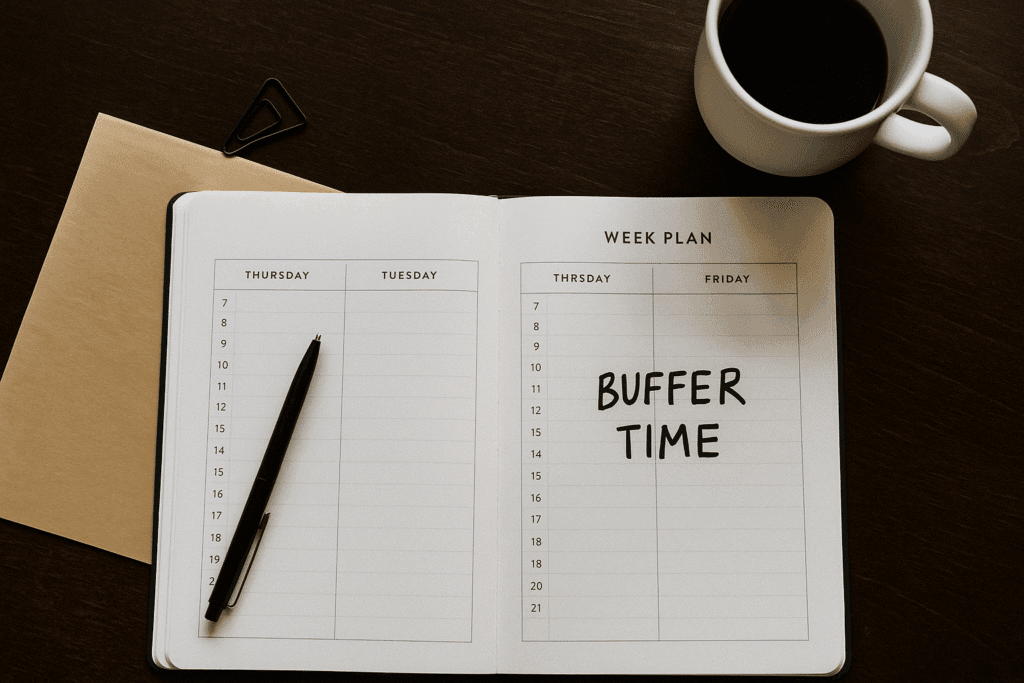Have you ever reached the end of the week and wondered where all your time went? You’re not alone. For many people, the week starts with good intentions and ends in a whirlwind of missed tasks, rescheduled meetings, and stress.
Learning how to plan your week effectively isn’t just about getting more done—it’s about creating structure, reducing anxiety, and making space for what truly matters. A well-planned week helps you take control of your time instead of letting your time control you.
In this article, you’ll learn a simple, step-by-step approach to plan your week with intention. No complex systems. No overwhelming tools. Just clear, actionable steps to help you stay focused, flexible, and on track.
Whether you’re managing work, family, or personal goals, the techniques here can help you make your week feel less chaotic—and a lot more productive.

Step 1: Start with a Weekly Overview
The first step to planning your week effectively is to take a broad look at what’s ahead. Before diving into specific tasks or to-do lists, start by identifying your key commitments, appointments, and deadlines. This overview sets the tone for the rest of your planning process and helps you stay grounded.
Pick a consistent day and time to do your weekly planning. Most people find that Sunday evenings or Monday mornings work best, but the ideal moment is whenever you can reflect without distractions. Open your calendar—digital or paper—and scan for events already scheduled, such as meetings, family obligations, or project due dates.
Once your non-negotiables are in place, you can begin to see the available spaces in your week. This helps prevent overbooking and gives you a clearer idea of how much time you really have to work with. If you’re using a digital calendar like Google Calendar or Notion, consider color-coding different areas of your life: work, personal, health, and so on.
This overview doesn’t need to be complicated. Even just 10 to 15 minutes of intentional review can give you the clarity needed to plan with purpose instead of rushing from one task to the next.
Step 2: Set Clear Priorities for the Week
Once you have an overview of your week, it’s time to define what truly matters. Setting clear priorities is the difference between feeling productive and just staying busy. Without prioritization, it’s easy to fill your days with low-impact tasks while important goals fall through the cracks.
Start by identifying your top 3 to 5 priorities for the week. These should align with your bigger goals—whether they’re personal, professional, or health-related. Avoid vague items like “work on project” and instead be specific: “finish outline for Q2 report” or “record two podcast episodes.”
A helpful tool here is the Eisenhower Matrix, which helps separate tasks into four categories: urgent and important, important but not urgent, urgent but not important, and neither. This visual method helps you see which tasks to tackle first and which can be scheduled, delegated, or even deleted.
Remember, a clear focus leads to less decision fatigue. By identifying your key priorities upfront, you create a filter for every task that comes your way throughout the week—and that clarity will save you time, energy, and stress.
Step 3: Break Down Tasks into Daily Actions
It’s one thing to know your weekly priorities—it’s another to make them happen. The secret is in breaking each priority down into small, manageable tasks that fit into your daily schedule. This step turns your plans into progress.
Take each of your 3 to 5 priorities and ask, “What specific steps need to happen to complete this?” For example, if one of your goals is to write a presentation, your action steps might be: outline key points, design slides, write speaker notes, and rehearse. These become your daily targets.
Assign each task to a specific day, ideally with a realistic estimate of how long it will take. This avoids overloading your schedule and helps you see where time is truly available. Tools like time blocking, bullet journaling, or even sticky notes can help map this out visually.
Most importantly, don’t aim for perfection—aim for clarity. When your day starts with a clear roadmap, decision fatigue fades, and you’ll spend less time figuring out what to do and more time doing it.
Step 4: Leave Space for Flexibility
Even the best plans can get derailed—and that’s okay. Life happens. That’s why effective weekly planning isn’t about controlling every minute, but about building in space to adapt. When you leave room for flexibility, you reduce stress and give yourself permission to adjust without guilt.
One simple technique is to include buffer blocks in your schedule—small chunks of unscheduled time between meetings or focused work. These act as shock absorbers for the unexpected: a last-minute call, a task that takes longer than expected, or just the need for a mental break.
Another option is to leave an entire “flex day” or “catch-up hour” open in your week. Friday afternoons or midweek mornings often work well for this. It gives you a chance to review what’s pending and reassign unfinished tasks without throwing off your momentum.
Planning flexibility isn’t a weakness—it’s strategic. By acknowledging that not everything will go as planned, you build a schedule that’s not just productive, but sustainable.

Step 5: Review and Adjust as You Go
Planning your week is just the beginning. To truly stay on track, you need to check in with your plan and adjust as life unfolds. This doesn’t mean rewriting your entire week every day—but a few intentional minutes of reflection can make a big difference.
At the end of each day, take 5 minutes to review what you completed, what’s pending, and how your energy felt. Ask yourself: Did today go as planned? What took longer than expected? What can I adjust tomorrow to make things smoother?
Weekly reviews are just as important. Block out 10 to 15 minutes—perhaps on Sunday evening or Friday afternoon—to reflect on what worked, what didn’t, and what needs to carry over. This is your chance to celebrate small wins and refine your approach before the next week starts.
By reviewing consistently, you’re not just managing your time—you’re improving how you manage it. It’s how planning becomes habit, and how habit leads to long-term growth.

Planning your week doesn’t have to be a rigid or overwhelming task. With a few intentional steps—reviewing your commitments, setting priorities, breaking down tasks, building in flexibility, and reflecting regularly—you can take control of your time in a way that supports both productivity and peace of mind.
Remember, the goal isn’t to squeeze more into your week, but to make space for what really matters. When you approach each week with clarity and purpose, everything flows a little better—from work to wellness to personal goals.
You don’t need to master every technique at once. Pick one strategy from this article and try it in the coming week. Over time, small adjustments lead to big results.
Share this article with someone who needs help planning their week.
You might just help them take the first step toward a more balanced and intentional life.

Daniel Carter believes that small daily changes lead to extraordinary results. Through simple and effective strategies, he inspires readers to take control of their routines, overcome procrastination, and unlock their full potential.











